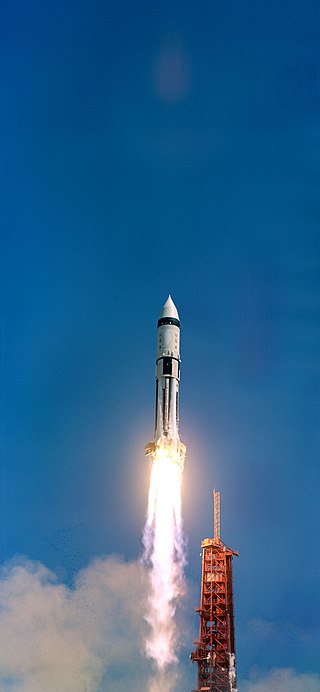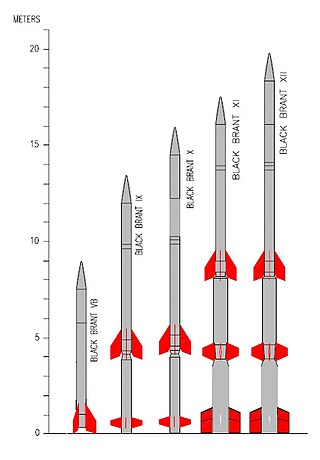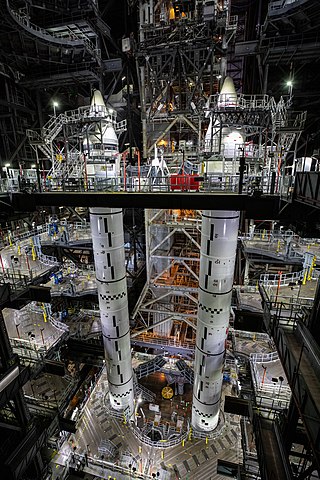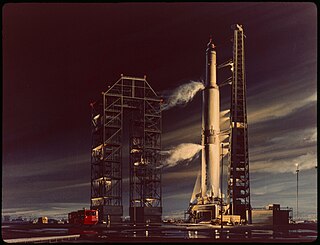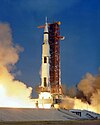 Saturn II proposals: INT-17, INT-18, INT-19. | |
| Function | Orbital launch vehicle |
|---|---|
| Manufacturer | North American (S-II) Douglas (S-IVB) |
| Country of origin | United States |
| Size | |
| Height | 167 feet (51 m) |
| Diameter | 33 feet (10 m) |
| Mass | 1,112,000 to 4,178,200 pounds (504,400 to 1,895,200 kg) |
| Stages | 2 |
| Capacity | |
| Payload to LEO (100 nmi (185 km), 28° inclination) | |
| Mass | 47,000 to 146,400 pounds (21,300 to 66,400 kg) |
| Associated rockets | |
| Family | Saturn |
| Derivative work |
|
| Launch history | |
| Status | Study 1966 |
| Launch sites | Kennedy Space Center Launch Complex 39, |
| Total launches | 0 |
| Boosters (INT-18) – UA1207 | |
| No. boosters | 2 or 4 |
| Powered by | 1 |
| Maximum thrust | 1,600,000 lbf (7,100 kN) SL |
| Total thrust | 3,200,000 lbf (14,000 kN) or 6,400,000 lbf (28,000 kN) SL |
| Specific impulse | 272 seconds SL |
| Burn time | 120 seconds |
| Propellant | APCP |
| First stage (INT-17) –S-II–INT-17 | |
| Height | 81.49 feet (24.84 m) |
| Diameter | 33.0 feet (10.1 m) |
| Empty mass | 105,000 pounds (48,000 kg) [note 1] |
| Gross mass | 1,091,000 pounds (495,000 kg) [note 1] |
| Powered by | 7 HG-3-SL |
| Maximum thrust | 1,334,000 lbf (5,930 kN) SL |
| Specific impulse |
|
| Burn time | 200 seconds |
| Propellant | LH2 / LOX |
| First stage (INT-18) –S-II | |
| Height | 81.49 feet (24.84 m) |
| Diameter | 33.0 feet (10.1 m) |
| Empty mass | 86,090 pounds (39,050 kg) [note 1] |
| Gross mass | 1,082,000 pounds (491,000 kg) [note 1] |
| Powered by | 5 Rocketdyne J-2 |
| Maximum thrust |
|
| Specific impulse |
|
| Burn time | 390 seconds |
| Propellant | LH2 / LOX |
| Second stage –S-IVB-200 | |
| Height | 58.3 feet (17.8 m) |
| Diameter | 21.68 feet (6.61 m) |
| Empty mass | 28,400 pounds (12,900 kg) [note 2] |
| Gross mass | 261,900 pounds (118,800 kg) [note 2] |
| Powered by | 1 Rocketdyne J-2 |
| Maximum thrust | 231,900 lbf (1,032 kN) vac |
| Specific impulse | 421 seconds (4.13 km/s) vac |
| Burn time | 475 seconds |
| Propellant | LH2 / LOX |
The Saturn II was a series of American expendable launch vehicles,studied by North American Aviation under a NASA contract in 1966,derived from the Saturn V rocket used for the Apollo lunar program. [1] The intent of the study was to eliminate production of the Saturn IB,and create a lower-cost heavy launch vehicle based on Saturn V hardware. North American studied three versions with the S-IC first stage removed:the INT-17,a two-stage vehicle with a low Earth orbit payload capability of 47,000 pounds (21,000 kg);the INT-18,which added Titan UA1204 or UA1207 strap-on solid rocket boosters,with payloads ranging from 47,000 pounds (21,000 kg) to 146,400 pounds (66,400 kg);and the INT-19,using solid boosters derived from the Minuteman missile first stage.
Contents
For this study,the Boeing company also investigated configurations designated INT-20 and INT-21 which employed its S-IC first stage,and eliminated either North American's S-II second stage,or the Douglas S-IVB third stage. Budget constraints led to cancellation of the study and exclusive use of the Space Shuttle for orbital payloads.

